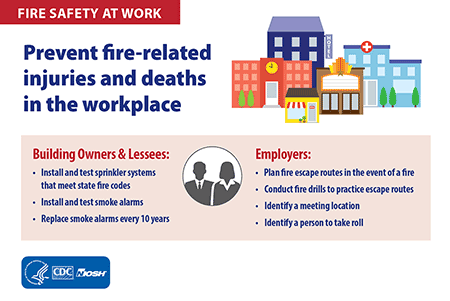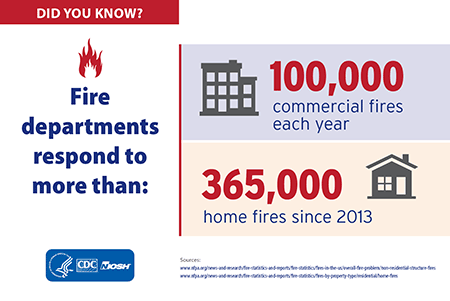Fire Prevention Week

October 8-14 is Fire Prevention Week. Learn steps you can take to prevent fires.
Since 2013, fire departments have responded to over 365,000 home structure fires1 and 100,000 non-residential fires each year.2 From 2010-2014, fire departments responded to a structure fire every 63 seconds.3 Many of these structures were not equipped with prevention devices, such as smoke alarms or sprinkler systems.
Fires put you, your family, fire fighters, and emergency workers at risk for injury and death. In 2015 alone, more than 2,600 people3 and 16 on-duty fire fighters died in structure fires.4 Whether you are a home owner, building owner, or employer, you can take action to prevent fire-related injury and death.
Prevent home fire injuries and deaths:
- Place smoke alarms on every floor of the home and in- and outside of sleeping areas
- Test smoke alarms at least once a month
- Replace smoke alarms every 10 years
- Plan an escape route that shows 2 ways out of every room, and practice it at least two times a year
Prevent workplace fire injuries and deaths:
- If you are a building owner or lessee:
- Install and test sprinkler systems that meet state fire codes
- Install smoke alarms in areas free of clutter, dust, and protected from potential damage
- Replace smoke alarms every 10 years
- If you are an employer:
- Plan escape routes in the event of a fire
- Conduct frequent fire drills to practice escape routes
- Identify a meeting location upon escape
- Identify a person to take roll at the meeting location
Fire Prevention Efforts Keep People and Fire Fighters Safe
Working smoke alarms aid people in escaping to safety quickly. When people are safely outside burning homes and buildings it reduces the need for fire fighters and other emergency workers to risk injury or death by entering a burning structure to search for them. Installing sprinkler systems that meet state codes help contain and put out fires, saving personal property and reducing risks for fire fighters responding to the fire.
More Information
References
- NFPA [2016]. Home fires.
- NFPA [2016]. Non-residential structure fires.
- NFPA [2017]. Fact sheet research: An overview of the U.S. fire problem.
- USFA [2017]. U.S. fire statistics: Fire fighters and fire departments.
- Page last reviewed: October 10, 2017
- Page last updated: October 10, 2017
- Content source:
- National Institute for Occupational Safety and Health, Division of Safety Research
- Page maintained by: Office of the Associate Director for Communication, Digital Media Branch, Division of Public Affairs




 ShareCompartir
ShareCompartir

